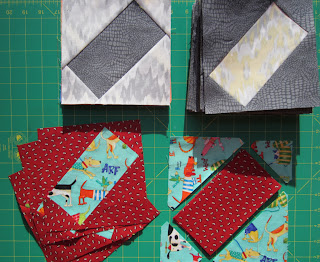May 4, 2012
Previous posts
1/3 3/3
The tale of Anita, Ginger, Fred, and two PDFs
I created "Ginger and Fred" especially for Quiltmaker's 100 Blocks Vol 5
and, for
Quiltmaker readers, the two Make It Simpler PDFs found below. If you've read my book
Rotary Cutting Revolution from C&T Publishing, 2010, you'll recall similar projects.
Q: What do you like best about Ginger and Fred?
Look at the rectangles. They dance and float. Unlike their parent block “
Good Fortune,” their corners aren’t designed to meet let alone match up. If the centers of each block don't meet, that won't be obvious either.
Four 12½" unfinished Ginger and Fred blocks (24" square, finished)
Q: Do you have a special way to cut the fabric patches not in the issue?
Yes. I use my CuttingLinesTM pattern instead of cutting individual squares and rectangles. I can cut enough pieces for two 12" blocks (40 pieces) in four rotary cuts from a stack of eight 8" starched fabric squares. Without waste.
Q: Huh?
When I sewed clothing, I positioned a large tissue paper pattern on folded fabric and cut through the printed tissue for the garment pieces. I learned to sew in the ‘60s at the Singer Sewing Center on Falls Street. In Niagara Falls, site of hydroelectric power plants, I was sewing 'Carnaby St Mod' shifts at home on a treadle machine.
Q: So you cut through tissue to get the pieces for a block?
I cut through ordinary photocopy paper
Q: What about special rulers or dies?
Not to cut through a paper pattern. Any straight edge ruler and rotary cutter will do
Q: Is fabric bias a concern?
No, because the outside edges of the block are straight of grain.
The rectangle has bias edges but, advantageously, directional fabric will maintain it’s direction. If you were to cut individual rectangles on grain, any motif would wind up tilting 45 degrees in the block.
Q: What's the method?
- Download this The Ginger and Fred Pattern PDF, trim away excess margin leaving the red lines intact (above)
- Cut or tear starched fabric into squares, at least 8" on each side
- Stack fabric squares, preferably right sides up. Stack as many as you can comfortably cut through. I cut 8 squares at a time which is enough for two blocks
- Use a repositionable gluestick (3M) or Collins Fabric Gluestick to adhere the pattern to the uppermost fabric square
- Cut the stack through the red outside lines, for accurately cut 7¼" squares (no measuring!)
- Without disturbing the stack, line up a ruler with any 1 of the 4 diagonal lines. Cut the stack along the ruler's edge completely from one edge of the paper to the other. Repeat to make 4 cuts.
Beneath each of the 5 paper shapes is a red fabric patch
Q: Speaking of bias, will the triangles be large enough?
Yes, they are sufficient and accurate and cut from stabilized (starched) fabric. If you have difficulty sewing corner triangles, as these are called, cut oversize triangles.
Cutting oversize: Cut fabric squares at least 8
½" instead of 8" Rather than cutting through the outside red lines, cut
¼" outside of the red lines. Cut along the diagonal lines as described above. The rectangle should and must remain the same size, (6 -1/8 x 3-3/8 inches) but the triangles will be oversize.
Q: Do you have a special way to sew the block together?
Yes. I use the pattern for top paper piecing as well; I'll post the explanation this month. If you are in a hurry, see p69 of Rotary Cutting Revolution
Q: How do you true-up this block when oversize triangles are used?
I make a true-up square
With a permanent fabric marker, trace a rectangle (only), using this
True Up Guide, onto a 6
½" acrylic square. Center the marked ruler over the pieced block and trim away any excess fabric.
The marks may be removed with alcohol
Q: Have you made a quilt of these blocks?
Yes. It's kind of Mod. But I didn't sew it on a treadle. It's “Fred and Ginger Hit the Road” It’s among the 15 quilts in the Quiltmaker Designer’s Gallery in Quiltmaker's 100 Blocks Vol 5
Ginger and Fred Hit the Road
Q: Really, Fred and Ginger are in the above quilt?
Yes. I'll explain that process during this month. Right now you have plenty of blogs to read and I hope some weekend sewing .
For the opportunity to win a copy of Quiltmaker’s 100 Blocks, Volume 5, please comment by noon Monday, eastern time, telling me where in the world you live. Comment anyway, I'd like to know where you are! Feel free to ask questions about the block techniques.
Q: What other blocks have you engineered CuttingLines
™ for?
Here's an
example J
If you don't see the "Post a Comment" link way below, click on "Links to this post" and look to the bottom to post a comment.
May 7, 2012: The Draw
In essence, everyone received a gift to celebrate the Vol 5 issue of 100 Designers, i.e. my CuttingLines™ PDFs linked above. Jitka, won the giveaway but I received a jackpot: The Comments. I felt as if I traveled the world over the weekend. I appreciate your making the time to write them.
Stay tuned for continued instructions regarding the Ginger and Fred block. Let’s face the music and quilt.
Trip the light fantastic with
Quiltmaker
Anita































































